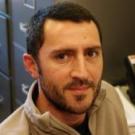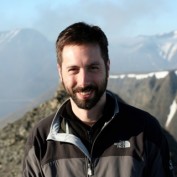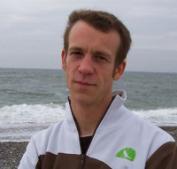PAOC Spotlights
New Oceans Faculty Positions Shine Spotlight on PAOC
September’s here, and classes in MIT’s Program in Atmospheres, Oceans, and Climate (PAOC) have begun. Faculty, post docs, researchers, and graduate students continue to explore the ocean on computers, in lab experiments, and on oceanographic research cruises. At the same time, we’re hearing echoes of PAOC’s programs in oceanography and the ocean’s role in climate far beyond MIT, as several past graduates and post docs gain new faculty appointments at top universities.
From new expertise in oceanic fluid dynamics at Columbia University and the University of Chicago, to the introduction of oceanographic minds to SUNY Albany and University of Reading–it’s clear that MIT’s PAOC is creating welcome waves of change in next generation ocean-atmosphere research.
 Ryan Abernathey is now an assistant professor of Ocean and Climate Physics at Columbia University’s Lamont-Doherty Earth Observatory.
Ryan Abernathey is now an assistant professor of Ocean and Climate Physics at Columbia University’s Lamont-Doherty Earth Observatory.
Abernathey first came to PAOC to study in the Climate Physics and Chemistry graduate program, but transformed into a physical oceanographer studying under MIT professor John Marshall. He eventually focused his graduate work on the physics of mixing and transport by ocean eddies and applied recent advances in ocean mesoscale turbulence to a theory of the Southern Ocean overturning circulation. Physical oceanography gave Abernathey an opportunity to nurture his talent for video-making. He visualized much of his data and simulations, such as his numerical model of the Southern Ocean. During his post doc at Scripps Institution of Oceanography, he worked with Paola Cessi to understand how interaction of the Antarctic Circumpolar Current with large topographic features affects the Southern Ocean stratification. Now settled in at Columbia University’s Lamont-Doherty Earth Observatory, he’s continuing his work on mixing processes and their role in ocean circulation and plans to venture into paleoclimatology.
PAOC is… “Arguably one of the best graduate programs in the world for studying geophysical fluid dynamics in a way that is relevant for important large-scale problems in the climate system. The PAOC graduate classes delve deeply into many aspects of ocean and atmospheric dynamics. The high degree of interaction between oceanographers and atmospheric scientists, which I took for granted while at MIT, is something unique and powerful.” –Ryan Abernathey, PhD ’12 MIT
 David Ferreira departed MIT earlier this summer, after spending almost exactly eleven years exploring the dynamics of the coupled ocean-atmosphere-sea ice system with John Marshall. As of July 1, he is Lecturer in Oceanography and Climate Dynamics in the Department of Meteorology at the University of Reading.
David Ferreira departed MIT earlier this summer, after spending almost exactly eleven years exploring the dynamics of the coupled ocean-atmosphere-sea ice system with John Marshall. As of July 1, he is Lecturer in Oceanography and Climate Dynamics in the Department of Meteorology at the University of Reading.
Ferreira joins a lab largely dominated by a meteorological and atmospheric focus, with the task of bringing an oceanographic perspective into his new collaborations. “That said,” he notes, “I may have to work hard to keep the ocean in the picture and not be engulfed by the atmospheric scientists.” His research at MIT is a precedent for such an ability. Recently, Ferreira and co-author Brian Rose (see below) proved the power of ocean-atmosphere-ice simulation in resolving key climate processes. The study, published in the Journal of Climate and featured on Oceans at MIT, describes how water vapor in the atmosphere could have helped the ocean of 55 million years ago transport heat from the equator to the poles, suggesting a potential solution to a vexing climate mystery.
PAOC is…. “A place with a constant stream of smart people: students, post docs, visitors, and even faculty. And, having stayed so many years in PAOC, I had the chance to interact with many of these brilliant people. There are many departments where I know someone I met in PAOC, even here in Europe. Working with John Marshall was fun and exciting, and I’m already missing our discussions over coffee in the morning.” –David Ferreira, PhD ’02 Université Pierre and Marie Curie, Paris.
 Brian Rose is now Assistant Professor at the SUNY Albany Department of Atmospheric and Environmental Sciences. Rose has always been interested in the role of coupled atmosphere-ocean processes in the climate system over long time scales. As a graduate student at PAOC, he refined his ideas in his 2010 PhD thesis, entitled “Oceanic Control of the Sea Ice Edge and Multiple Equilibria in the Climate System,” and then continued as a post doc with John Marshall. Rose typically uses a “building blocks” approach to his research, constructing an understanding of the complex climate system through “judicious simplification.” He attributes this way of thinking to his years working with Marshall. “He reinforced in me the power of a cartoon–if you can’t draw a sketch of the essence of a process, you don’t understand it properly,” Rose says.
Brian Rose is now Assistant Professor at the SUNY Albany Department of Atmospheric and Environmental Sciences. Rose has always been interested in the role of coupled atmosphere-ocean processes in the climate system over long time scales. As a graduate student at PAOC, he refined his ideas in his 2010 PhD thesis, entitled “Oceanic Control of the Sea Ice Edge and Multiple Equilibria in the Climate System,” and then continued as a post doc with John Marshall. Rose typically uses a “building blocks” approach to his research, constructing an understanding of the complex climate system through “judicious simplification.” He attributes this way of thinking to his years working with Marshall. “He reinforced in me the power of a cartoon–if you can’t draw a sketch of the essence of a process, you don’t understand it properly,” Rose says.
As a post doc in the Department of Atmospheric Sciences at the University of Washington, hosted by Professor David S. Battisti, Rose developed a fascination in radiative processes involving atmospheric water vapor, and particularly in the role of ocean heat uptake and transport. He sees these processes and mechanisms as fundamental rules of the climate system, which can deepen our understanding of past and future climates, even on other planets.
Rose’s first faculty appointment takes him to SUNY Albany’s Department of Atmospheric and Environmental Sciences, which has traditionally been oriented towards weather and forecasting. “But the department has nearly doubled the size of its faculty in the last few years, and in doing so, has managed to build considerable expertise in climate. It’s very exciting to join in the midst of this renaissance,” Rose says. Now, he and other assistant professors will develop a new curriculum and build research groups in completely new areas. Like his collaborator David Ferreira, he brings a welcome expertise in climate and oceanography to his new academic home.
PAOC is…. “An enormous influence on me. I got very rigorous training through my course work, particularly in geophysical fluid dynamics. Beyond that, the PAOC faculty as a whole always encouraged us to think about fundamentals and work to really understand problems. This is a big deal in a field of study that’s dominated by intensive computer simulation. I enjoyed the inter-mingling of oceanographers and atmospheric scientists in PAOC, both on the faculty and student levels. It created a very natural atmosphere within which to learn and think about coupled atmosphere-ocean-climate problems.” –Brian Rose, PhD ‘10 MIT
 Malte Jansen’s new appointment as Assistant Professor in the Department of Geophysical Sciences at the University of Chicago begins in 2015. He currently works as a post doc at the Geophysical Fluid Dynamics Laboratory/ Princeton University focusing on ocean turbulence and its representation in climate models.
Malte Jansen’s new appointment as Assistant Professor in the Department of Geophysical Sciences at the University of Chicago begins in 2015. He currently works as a post doc at the Geophysical Fluid Dynamics Laboratory/ Princeton University focusing on ocean turbulence and its representation in climate models.
Jansen’s PhD thesis at PAOC focused on large-scale turbulence in the atmosphere, and touched on the comparison of current understandings of turbulence in the ocean versus the atmosphere. During his brief time as a post doc with Professor Raffaele Ferrari, he concentrated on ocean circulation during the peak of the last glacial period about 20,000 years ago and its role in the carbon cycle.
Since then, Jansen has melded both of these interests and plans to pursue ocean turbulence and its role in the past and present climate at the University of Chicago. He may also broaden his research beyond Earth’s oceans and climate. “Chicago has a number of very strong faculty studying the atmospheres of exoplanets,” he says, “which might also foster some collaborations in which I would look specifically at the possible dynamics of these atmospheres.
” PAOC is…. “A great education. I very much enjoyed working with my advisor, Raffaele Ferrari. He challenged me scientifically, and also inspired me with his own enthusiasm to try and better understand the physics of the ocean and the climate system.” –Malte Jansen, PhD ‘12 MIT
Related
Highlights of the Southern Ocean Workshop on Oceans at MIT